AMD Ryzen Threadripper 7980X & 7970X Review: Revived HEDT Brings More Cores of Zen 4
by Gavin Bonshor on November 20, 2023 9:00 AM EST- Posted in
- CPUs
- AMD
- HEDT
- ThreadRipper
- Zen 4
- Threadripper 7000
- TRX50
TR 7000 vs. Intel: Power and Compile
Our previous sets of ‘office’ benchmarks have often been a mix of science and synthetics, so this time, we wanted to keep our office and productivity section purely based on real-world performance. We've also incorporated our power testing into this section. Given the nature and target market of the Ryzen Threadripper 7000 series, we've opted to focus on tasks such as compiling.
We are using DDR5-5200 RDIMM memory on the Ryzen Threadripper 7980X and 7970X as per JEDEC specifications. For Intel's Xeon W9-3495X, we are using DDR5-4800 RDIMM memory as per Intel's JEDEC specifications. It should be noted that both platforms are run with their full allocation of memory channels, e.g., TR7000 in 4-channel and Sapphire Rapids in 8-channel.
Below are the settings we have used for each platform:
- DDR5-5200 RDIMM - AMD Threadripper 7000
- DDR5-4800 RDIMM - Intel Xeon Sapphire Rapids WS
- DDR5-5600B CL46 - Intel 14th Gen
- DDR5-5200 CL44 - Ryzen 7000
Power
The nature of reporting processor power consumption has become, in part, a bit of a nightmare. Historically the peak power consumption of a processor, as purchased, is given by its Thermal Design Power (TDP, or PL1). For many markets, such as embedded processors, that value of TDP still signifies the peak power consumption. For the processors we test at AnandTech, either desktop, notebook, or enterprise, this is not always the case.
Modern high-performance processors implement a feature called Turbo. This allows, usually for a limited time, a processor to go beyond its rated frequency. Exactly how far the processor goes depends on a few factors, such as the Turbo Power Limit (PL2), whether the peak frequency is hard coded, the thermals, and the power delivery. Turbo can sometimes be very aggressive, allowing power values 2.5x above the rated TDP.
AMD and Intel have different definitions for TDP that are, broadly speaking, applied the same. The difference comes from turbo modes, turbo limits, turbo budgets, and how the processors manage that power balance. These topics are 10000-12000 word articles in their own right, and we’ve got a few articles worth reading on the topic.
- Why Intel Processors Draw More Power Than Expected: TDP and Turbo Explained
- Talking TDP, Turbo and Overclocking: An Interview with Intel Fellow Guy Therien
- Reaching for Turbo: Aligning Perception with AMD’s Frequency Metrics
- Intel’s TDP Shenanigans Hurts Everyone
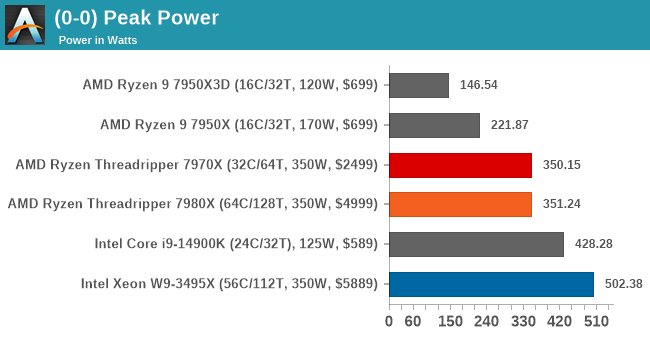
Looking at the max power we observed on the AMD Ryzen Threadripper 7980X and 7970X processors, we can see they hit and don't go robustly above their rated TDPs of 350 W. In contrast, the Intel Xeon W9-3495X peaked at a huge 502 W, well above the rated 350 W TDP. Compared to the desktop processors we've added to the data set, both Threadripper 7000 series processors are also considerably below the Intel Core i9-14900K.
Moving onto a deeper look at how the AMD Ryzen Threadripper 7980X compares to the Intel Xeon W9-3495X in Prime95 with Small FFTs, we can see that Intel's Sapphire Rapids WS option draws considerably more power. Despite having eight more cores than the W9-3495X, the Threadripper 7980X runs consistently within AMD's designated TDP of 350W; this is the TDP for all three AMD Ryzen Threadripper 7000 series SKUs. As we've highlighted in our desktop reviews of the Ryzen 9 7950X and Ryzen 9 7950X3D processors, we know AMD's Zen 4 core doesn't only deliver in performance, but it's a highly efficient core, too.
Compile/Database
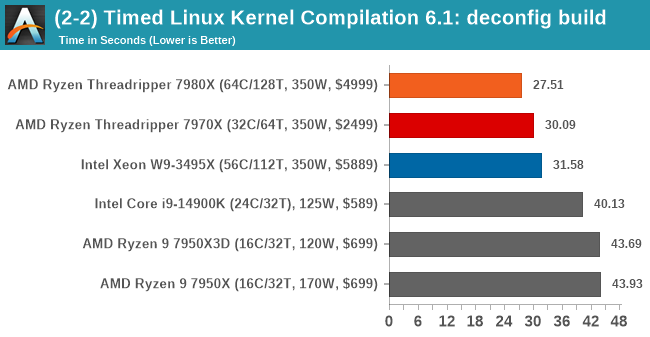
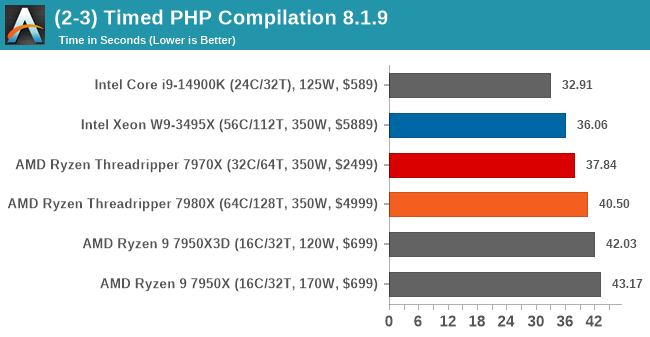
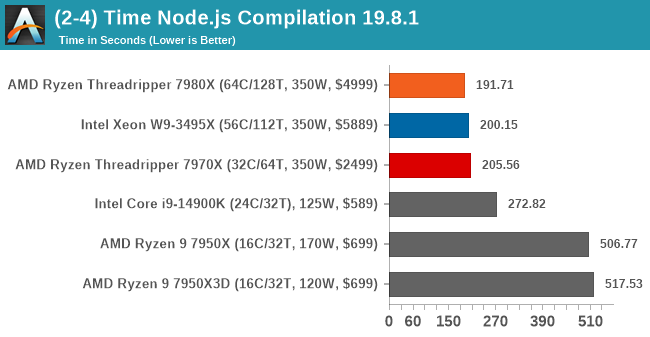
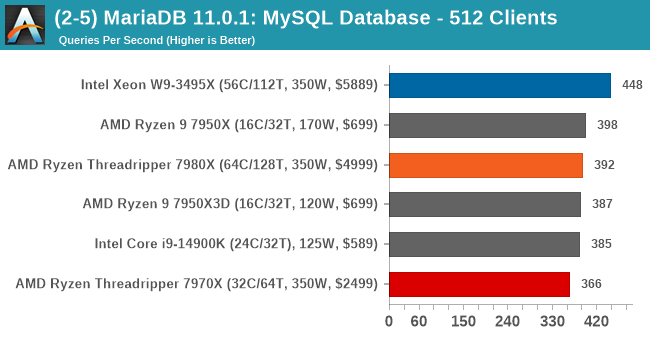
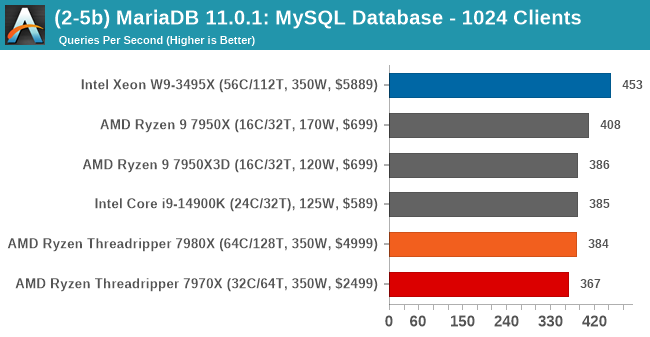
In our timed compilation benchmarks, including Linux Kernel, PHP, and Node.js, we can see that the Threadripper 7980X and 7970X perform well for the most part. In larger compilations such as Node.js, there's a significant advantage to having a higher core/thread count. Intel's Xeon W9-3495X beats all the chips we tested convincingly in the MariaDB MySQL database benchmark, with the flagship desktop chips also performing well here.


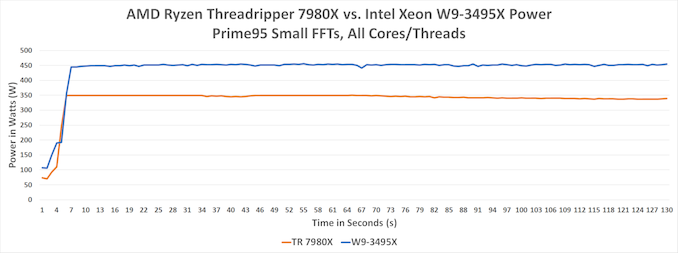








66 Comments
View All Comments
Threska - Wednesday, November 22, 2023 - link
Sounds like the complaint of a cheap person that doesn't want to spend their money on anything. Starts with a fruit-vegetable comparison and ends with an absurdly low-balled figure.SanX - Thursday, November 23, 2023 - link
It is better to be cheap than dumb. I wrote TR is 2x faster than consumer 7950X? Let's take this more precisely from "Science and Simulation" for example as scientists should do. Out of its 13 tests the TR 7980x won only 5. Even more, taking the mean square root of test ratios we can get that TR actually only 33% faster than 7950X3D. Couple tests look like a single core taking them out changes this outcome just 5%. What a misery, it is actually a TOTAL DEBACLE! Buy the way, just in case.tell your relatives to take the credit card from youBushLin - Thursday, November 23, 2023 - link
Tonight's Headlines:Guy on the internet with a narrow use case decrees AMD's entire HEDT lineup BS. His application runs just as well on a consumer platform so no one else could possibility find value...
SanX - Sunday, November 26, 2023 - link
YMMVSanX - Thursday, November 23, 2023 - link
"You know how much it costs to develop these chips? AN insane amount of money."OK, tell us how much exactly.
AMD first introduced chiplets in 2015. The cost of that development returned many times since. As to the cost of chiplets themselves, Zen4 chiplets have around 6B transistors. Apple Bionic A14 chip has twice of that and costs $17. Do the math
Shmee - Wednesday, November 22, 2023 - link
I wonder why there is no 16 core option. It would be nice to have a less expensive HEDT CPU for gaming, with higher clocks. Also, why no gaming benchmarks?Oxford Guy - Wednesday, November 22, 2023 - link
Games aren't designed to leverage these chips (too many cores, not enough clock, no 3D cache, too much inter-module latency).Games are designed for low-end CPUs, comparatively.
As for a 16-core version, it wouldn't be enough cores to justify the cost of the motherboard unless AMD were targeting extreme clocks, which the company isn't.
mvkorpel - Thursday, November 23, 2023 - link
The 7970X actually has a max boost clock of 5.3 GHz, according to AMD. It is reported as 5.1 GHz in the article.PeachNCream - Sunday, November 26, 2023 - link
HEDT is a terribly scammy space for CPUs. The markup for overall compute power is high, the maximum CPU clocks are low, power consumption and cooling is crazy, and then there is the biggest issue - per CPU memory bandwidth to RAM. Modern 4-8 core laptop CPUs get two memory channels. This chip gives you a measly 4 channels far more processor cores to squabble over. That's woefully inefficient scaling to say the least and I'm sure someone will start crying about wiring complexity in a world where we have 172-layer stacked NAND and hundreds of CPU cores on a single chip package while ignoring that wiring for 8 memory channels would be trivial with a little bit of effort and thought put into it.TomWomack - Monday, November 27, 2023 - link
Usually secondhand last-generation servers are a better source of pure computrons than HEDT; on the other hand third-generation Xeon Scalable with eight channels per processor hasn't made it to the second-hand market yet, and whilst the less-popular many-core Skylake CPUs are under £100 the base systems are still quite expensive and the stock levels aren't great.